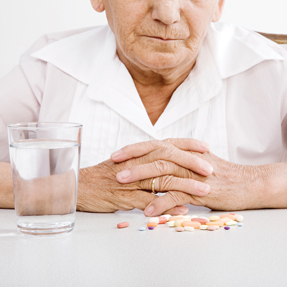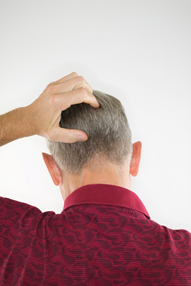Finesse required to treat anxiety in the elderly
Elderly patients may have many concerns on their mind. Maintaining their independence and managing their finances are two. But when does worry become anxiety? And how can internists not only manage chronic diseases but also ensure that patients are able to care for themselves?.
A certain amount of stress and anxiety are a part of life, and as patients age, it's natural that their concerns shift from their careers and the safety of their children to maintaining their own independence, managing finances and even coping with grief. But when anxiety interferes with a senior's ability to get through the day, it's no longer simple worry. It could be an anxiety disorder.
The National Comorbidity Survey-Replication (NCS-R) study, published in the September 2009 American Journal of Geriatric Psychiatry, estimated that 7% of adults age 65 and older meet criteria for an anxiety disorder. Chances are that internists will encounter many of these patients.

In a 2007 study appearing in the Primary Care Companion of the Journal of Clinical Psychiatry, roughly 40% of participants age 19 to 92 reported anxiety symptoms, showing the disease's prevalence in the general population. Another study published in International Psychogeriatrics in 1999 suggested that 30% of older adults in primary care settings present with generalized anxiety symptoms. As the population ages and baby boomers head into their senior years, the overall number of elderly patients with anxiety will only increase.
Diagnosing anxiety disorders in the elderly is tricky because comorbidities and certain medications may cause similar symptoms, but a patient's behavior can provide clues, said Thomas Magnuson, MD, associate professor at the University of Nebraska Medical Center Department of Psychiatry in Omaha.
“General symptoms such as high heart rate, increased blood pressure, trouble focusing, headaches, and pain make it difficult to make a determination,” he said. “However, if the patient is looking harried, seems nervous, paces, or moves around a lot, those could be signs of anxiety.”
Discussing the patient's mental health history is imperative because most anxiety disorders first appear earlier in life, said David R. Thomas, MD, FACP, a geriatrician and professor of medicine at the St. Louis University School of Medicine in Missouri. Indeed, the NCS-R determined that fewer than 1% of individuals will first develop an anxiety disorder after age 65.
“Usually there is a history where the anxiety is triggered by past events, things got better, and now it's back,” Dr. Thomas said. “But if this is the first time, that is where the internist needs to apply his or her medical skills to see if there is some sort of change or developing condition that may be producing the symptoms.”
Populations at risk
According to a comprehensive literature review appearing in the February 2010 Depression and Anxiety, several patient populations are at increased risk of having an anxiety disorder in their senior years: women, patients with several chronic medical conditions, patients who are not married (e.g., those who are single, divorced or separated), patients with less formal education, patients with impaired subjective health, patients with physical limitations who have difficulty performing daily activities, patients who experienced adverse events in childhood, patients who are diagnosed with neuroticism, and patients who have suffered stressful life events.
Sussing out that last risk factor—stressful life events—is part and parcel of taking a medical history, said James T. Pacala, MD, MS, associate professor and distinguished university teaching professor at the University of Minnesota Medical School in Minneapolis and president of the American Geriatrics Society.
“If the patient appears to be ruminating, or if they talk about sleep problems, you can ask them if they've experienced any life-changing events,” he said. These could include separation or divorce, a change in living arrangements, loss of a loved one, or retirement.
“If you discover that the patient has been through a stressful situation, you can just ask, ‘How are you holding up?’ or ‘How are your nerves?,’” Dr. Pacala said.
Internists should be on the lookout for elder abuse and neglect, and also alcohol abuse, which can cause significant anxiety, said Marvin Omar Delgado Guay, MD, assistant professor of medicine in the department of palliative care and rehabilitation medicine at the University of Texas M.D. Anderson Cancer Center in Houston. “There are several key signs, such as bruises, unexplained falls at home, missed appointments, or being dressed inappropriately.”
Dr. Delgado Guay suggests checking the number of pills in patients' prescription bottles. “If they have not been taking their medications, that can be a sign of neglect. If they are running out of their medications too soon, is something at home making them feel like they have to take the medication to cope?” Another possibility is that someone else in the home could be taking the medication. Over- or under-medication can worsen coexisting conditions or anxiety disorders, he added.
Challenging comorbidities
Several studies indicate that between 80% and 86% of seniors have at least one chronic medical condition, so it stands to reason that comorbid conditions are common in elderly patients with anxiety.
According to studies analyzed in the Depression and Anxiety literature review, several medical conditions are associated with anxiety disorders and symptoms, including gastrointestinal conditions, hyperthyroidism, diabetes, cardiovascular disease, and respiratory disorders, notably chronic obstructive pulmonary disease (COPD).
The symptoms of these conditions may mimic those of anxiety disorders. For example, rapid heartbeat may be a symptom of hyperthyroidism. But the symptoms of the diseases themselves can give rise to anxiety, said Dr. Magnuson. “If the patient has lung disease, not being able to breathe can cause significant anxiety,” he noted.
He added that seemingly unrelated conditions can tip the balance toward an anxiety disorder. “Patients with Parkinson's may develop anxiety from the disease, but other issues could arise. They may develop a social phobia about eating in public because of their shaking. They may start to restrict their lives and not go out in public.”
The most common psychiatric comorbidity is depression. Studies noted in the aforementioned literature review indicate that 23% of adults older than age 55 who have anxiety disorders also have depression. The reverse is true, as well, with studies indicating that 23% to 28% of patients age 60 and older with depression also have an anxiety disorder.
Dementia or other forms of cognitive impairment may also be present in patients with anxiety, said Dr. Pacala.
“This can happen in early dementia, where patients will have insight into their own cognitive issues. They can tell they are slipping and, understandably, that is distressing to them,” he said. “But it can go in the opposite direction as well. If you have someone who appears anxious, you might want to assess them for cognitive problems.”
The overlapping symptoms between comorbidities and anxiety mandate careful consideration when making a diagnosis, said Catherine E. DuBeau, MD, ACP Member, professor of medicine and clinical chief of geriatric medicine at the University of Massachusetts Medical School in Boston.
“If your first reaction is to prescribe, take a deep breath, put down your pen, and go back to your differentials,” she said. “The last thing you want to do is treat the symptom of another disease with the wrong medication. You want to make sure this is truly a classic anxiety disorder, whether it's generalized anxiety, post-traumatic stress disorder, a phobia, or obsessive-compulsive disorder.”
Dr. DuBeau added that alcohol abuse, excessive caffeine intake and withdrawal from benzodiazepines or sleep aids can all produce symptoms of anxiety as well as exacerbate existing anxiety disorders.
Finessing treatment
Optimal treatment for an anxiety disorder in an elderly patient will depend on the patient's overall health and comorbid conditions.
Dr. Thomas noted that depression in the elderly tends to manifest as anxiety, as opposed to the lethargy more common among younger sufferers. “That makes it easier for internists. Whether it's depression with an anxiety component or anxiety with a depression component, an antidepressant is a good first choice because antidepressants tend to be anti-anxiety.”
Studies included in the literature review suggest that citalopram, sertraline and extended-release venlafaxine improve anxiety in elderly patients. Other options include buspirone and bupropion.
Cognitive behavioral therapy (CBT) should also be considered, said Dr. Pacala.
“Bring in a counselor or therapist early, particularly with phobias and short-term anxiety,” he said. “Elderly people can be taught relaxation techniques, and many times that is preferable to using medication.”
According to a review in the March 2007 Psychology and Aging, researchers who evaluated 17 studies of evidence-based treatment found that relaxation training, CBT, supportive therapy and cognitive therapy were all effective in treating anxiety in elderly patients.
Experts agree that benzodiazepines should be approached with extreme caution in the elderly. “In terms of pharmacological interventions, benzos are one of the most dangerous classes of drugs for elderly patients. They increase the risk of falls and fractures, and they can precipitate delirium in those who already have cognitive impairment,” said Dr. Delgado Guay.
The American Geriatrics Society's Updated Beers Criteria for Potentially Inappropriate Medication Use in Older Adults, published in the April 2012 Journal of the American Geriatrics Society, highlight the risk of benzodiazepine use in older adults, noting that seniors have increased sensitivity to the drugs and slower metabolism of long-acting agents. The criteria recommend that benzodiazepines be avoided for the treatment of insomnia, agitation, or delirium, but add that the drugs may be appropriate in certain other conditions.
“The Beers Criteria is not so much a do-not-use list. It is a list of potentially inappropriate medications,” said Dr. DuBeau, who served on the 11-expert panel that updated the criteria. “The idea is that you take a patient-centered approach and weigh the risk and benefits for each patient.”
To that end, there may be cases where benzodiazepines may be helpful, said Dr. Pacala.
“These cases might be situation-specific. In my experience, they have been helpful for patients with specific, predictable phobias, like a patient who has to get on a plane to go to a family reunion but has a fear of flying,” he said. “If a spouse or child has died suddenly, and the patient goes to pieces, can't sleep, and is incapacitated by grief, I will consider putting the patient on a limited course of a benzodiazepine, and think about switching to a [selective serotonin reuptake inhibitor] if I feel the anxiety is going to last a while.”
Benzodiazepines may also be appropriate for treating anxiety at the end of life.
“Just be careful of the half-life,” said Dr. Thomas. “My observation is that a lot of hospice care providers use [lorazepam] as a knee-jerk reaction, but if you use it for too long, it builds up active metabolites. At best, the patients can become so lethargic they can't talk, which will not allow them to communicate with their families, get their affairs in order, and say their goodbyes. At worst, you can make someone comatose.”
The Beers Criteria caution against prescribing antipsychotics for elderly patients because of the risk of stroke and mortality in people with dementia. “Using an antipsychotic just for anxiety is generally inappropriate,” said Dr. Pacala. “The only cases where it would be OK would be if the anxiety has a prominent psychotic feature like delusions of aliens trying to land on the roof.”
If pharmacotherapy, behavioral therapy and cognitive or relaxation therapy don't work, then it's time to refer the patient to a specialist like a psychiatrist. “Referring in this case is parallel to any other situation in general practice,” said Dr. Pacala. “When the patient is resistant to the usual course of treatment, and you've tried different therapies and haven't gotten an adequate response, that's when you make the referral.”





